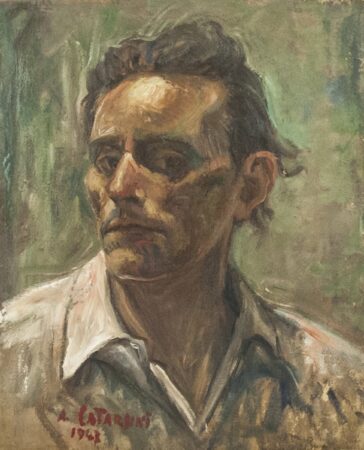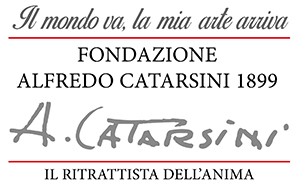FONDAZIONE ALFREDO CATARSINI 1899
 “Fondazione Alfredo Catarsini 1899” was born in July 2020 on the personal enterprising spirit of the Maestro’s niece and heir – Elena Anna Rita Martinelli – and her husband Gianvittorio Serralunga, in memory of Mity Catarsini.
“Fondazione Alfredo Catarsini 1899” was born in July 2020 on the personal enterprising spirit of the Maestro’s niece and heir – Elena Anna Rita Martinelli – and her husband Gianvittorio Serralunga, in memory of Mity Catarsini.
Inspired by the principles of the Third Sector – in addition to protecting and enhancing the intellectual and artistic work of the Maestro Alfredo Catarsini, in his multifaceted activity as a painter, writer, critic and animator of cultural proposals – it has among its statutory purposes that of pursuing , propose, enhance the promotion, dissemination, education, research, training of all activities related to “artistic disciplines” in all their forms and expressions through the dissemination and expansion of human knowledge, contacts between people , organizations and associations.
In particular, the “Fondazione Alfredo Catarsini 1899” carries out the following activities in an organized manner:
– research, studies, cataloging, concerning the history and cultural, didactic and artistic experience of Maestro Alfredo Catarsini and the “artistic disciplines” through the establishment of study centers, scholarships, Alfredo Catarsini Prize;
– widespread training of pictorial work and artistic disciplines in general, both for cognitive and training purposes for schools of all levels, art institutes, universities, also for social, socio-educational, inclusion and integration purposes;
– exhibitions, seminars, conferences, debates, internships, festivals and any other historical, artistic and cultural event of particular interest, proceeding with the publication of the related acts, documents and catalogs etc.
– preserve and enhance the historian archive and pieces of Maestro at “Atelier Alfredo Catarsini” – Civici
Musei di Villa Paolina Bonaparte.
Portrait of Mity Catarsini
ALFREDO CATARSINI

ALFREDO CATARSINI – PAINTER AND WRITER
Viareggio, 17 January 1899 – 28 March 1993
BRIEF BIOGRAPHICAL NOTES
Alfredo Catarsini was born in Viareggio, in the shadow of the Matilde Tower, in the house that had belonged to Ippolito Ragghianti, on January 17, 1899. He started painting very early, and was still a boy when he went to Paris where he met Amedeo Modigliani.
Lorenzo Viani considered him one of the most interesting young artists of Viareggio. In 1939 he won the “Cremona” prize, and in 1940 and 1941 his paintings were shown in Hannover, among the most important works from the same Cremona Prize. In 1942 he was invited to the XXIII Venice Biennale; in 1943 he took part in the IV Roman Quadrenniale. After the war, he again participated in the Venice Bienniale of ’48 and ’50, and in the Quadrenniale of ’52, ’56 and ’59.
His painting found inspiration from the sea and from his land, to which he maintained a deep and irreplaceable love, translated into the pictures of the docks, the yards, the boats, the sails, the caulkers and the fishermen. His long pictorial history – he died in Viareggio on 28 March 1993 – was always consistent with his inspiration, upon which he based all his works, landscapes, portraits, female figures, still lifes.
Silent and careful observer of the human environment and of the natural context, Garibaldo Alessandrini wrote about him in 1942, “… admirable for the purity of the design and the vigorous harmony.”
Throughout the twentieth century, he perceived the innovative turmoil of the “ismi”, experimenting all of them. His two periods of “Riflessismo” and “Simbolismo meccanico” referred to the drama of the civilization of machines, and of the alienation and loneliness of modern man.
After the war he taught at the “Stagio Stagi” Art Institute in Pietrasanta holding the chair of Live Drawing.
Dynamic and tireless, he actively contributed to the cultural life of Versilia, writing in newspapers and in the two magazines Versilia Oggi and Viareggio Ieri. In 1969 he published his first novel, “Giorni Neri”, set in Lucca during the period of displacement and the Resistance.
Between 1980 and 1992 he stayed for long periods in Lodi, where in 1990 he was awarded the prestigious “Arvini” prize.
His works are present in important public and private collections, including the Modern Art Galleries of Milan, Ferrara, Florence, Rome, Lodi, Viareggio, Paris and in the Munich Museum of Art.
Several art writers and critics wrote about him. Among the others Enrico Pea, Emanuele Bugatti, Everardo Dalla Noce, Paolo Levi, Tommaso Paloscia, Sergio Solmi, Pier Carlo Santini, Leonida Repaci, Mario Quadraroli, Alfonso Gatto, Krimer, Carlo Carrà, Raffaello Bertoli, Dino Carlesi, Enrico Dei, Nicola Micieli, Albert Schneeberger, Raffaele De Grada, Arnold Bode, Mario De Micheli, Antonio Paolucci, Cristina Acidini and Vittorio Sgarbi.
To honor the great and long friendship between him and Leonida Repaci, dating since the birth of the Viareggio Prize, one of his “Darsena” from the Riflessismo period was chosen as the poster of the 70th anniversary of the same Viareggio Repaci Prize.
In 2003 his Atelier in the attics of the Palazzo Paolina Bonaparte in Viareggio, which he used for more than 50 years until his death, was deeply refurbished. It is now possible to visit his restored studio which houses works, photos and its historical archive.
Florence remembered him in 2005 with a retrospective exhibition curated by Antonio Paolucci and Raffaello Bertoli at Palazzo Panciatichi, “Alfredo Catarsini, the Tuscan painter of emotion”.
In the same year his “Self-portrait” of 1934 went to enrich the Uffizi Museum Self Portrait Gallery.
In 2006 (62 years after their realization in the tragic last period of II World War) the frescoes painted by Catarsini in the apse of the church of S. Martino in Freddana were restored: the same community of the village had promoted the cleaning of the frescoes.
Every year, in May, the prize named after him is awarded to three students of the Higher Institutes of the Province of Lucca, winners of the “Drawing and Painting from true extempore” competition held in Viareggio.
A square in the city of Viareggio is named after him.


































